PLAC KAZIMIERZA WIELKIEGO
The name was given in 1869 to commemorate transfer of the Casimir III the Great’s ashes (1333 – 1370) to renovated tomb in the Wawel Cathedral on 8 July, 1869. Previously, the square was called Small Market and the Groats Square (hulled grain, i.e. groats were traded here).
ULICA KATEDRALNA
The name exists since around 1800. It was given during the Austrian Partition (German: Dom Gasse – ul. Katedralna – Katedralna Street). In the 16th century the street was named Krakowska, as it lead towards the Krakowska Gate. In 1950, the street was renamed to Walerego Wróblewskiego (1836–1908, a lieutenant in the January Uprising 1863–1864; general of the Paris Commune of 1871). In 1989, the old 19th c. street name of ul. Katedralna (Katedralna Street) was returned.
ULICA KRÓTKA
On a map dated 1848, the name of the street is presented as Kurze Gasse – ul. Krótka (Krótka Street). It was drawn when the city was established. Along the street there were the Municipal Police Stations. The most monumental building in the Krótka Street – nowadays, the seat of a bank – was constructed in 1892 as a banking enterprise taking items into deposit from impoverished townsmen.
ULICA WIELKIE SCHODY
In the 16th century, there was located an entrance gate, also called the Smaller Gate. After the city walls were knocked down, on the terrain slope there were constructed stairs. In 1848, the German name is in use – Stiegen Gasse – Schodowa Street. In 1881 the stairs were prolonged and the street was given name Schodowa Wielka, later Wielkie Schody.
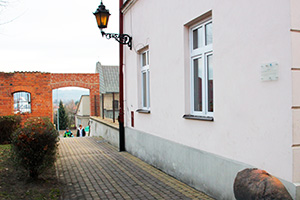
ULICA MAŁE SCHODY
In 1883, here, on the terrain slope there were constructed stairs in the direction of Bernandyńska Street – probably in the location of an entrance gate that connected the city with the St. Bernard’s convent. Originally, it was named Schodowa Mała Street.
ULICA WEKSLARSKA
The name applies since 1884. In the 16th century it was called Pilzneńska Street, in the 19th century Mieniarska Street or Wekslarska Street. The name comes from a German word Wechsel – exchange of money, since the Polish name Mieniarska.
ULICA BRAMA PILZNEŃSKA
As a name of street (Pilźnieńska Brama) it exists only since 1884 and has origin in the name of a gate present in the old city walls. The gate was deconstructed at the end of the 18th century.
ULICA ŻYDOWSKA
The name Żydowska Street (Latin: Platea Judaica) appeared in the municipal books of Tarnów in the 17th century and has been used until present. Along the street the Jews built their houses after they were allowed to settle within the town walls already in the 16th c.
ULICA PIEKARSKA
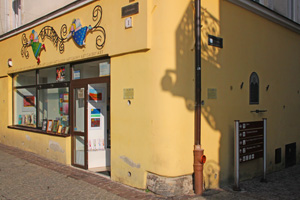
On the map of the city dated 1848, the street appears as Krämer Gasse Street, i.e. Kramarska Street. Undoubtedly, the name comes from stalls located in this street. Before 1884, it is called Żydowska Wyższa Street. Since 1884, its name was determined to be Piekarska Street.
ULICA RYBNA
Before 1884, it was called Piekarska Street, due to the fact that it led to Chlebowy or Piekarski Square, where bread was sold. When the name of the Piekarski Square was changed into Rybny in 1884, the street was named Rybna.
PLAC RYBNY
On the map of the city dated 1848, this square is named in German Brod (!) Platz – Chlebowy Square. However, in 1878 Bäcker Platz – Piekarski Square. In 1884, the name of the square was changed into Rybny Square.
ULICA FORTECZNA
The street name appeared in the Index of streets and squares in Tarnów in 1937/8. This is a part of an old street that ran on the inner side of the city walls of the fortified city.
ULICA BASZTOWA
In 1884, it was called Pochyła Street. In the ‘20s of the 20th century it was already called Basztowa. It was named after the tower (bastei) standing close to it, that was constructed in the middle of the 16th century.
ULICA KAPITULNA
In German the street name is Kapitel Gasse. It appears on the city map in 1848 r. The street name – Kapitulna, comes from the houses located in this street that were occupied by prelates and canon priests of the Tarnów Chapter House Cathedral.
PLAC KATEDRALNY
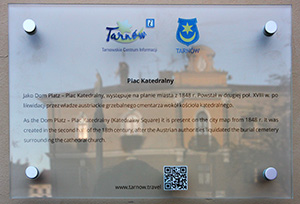
As the Dom Platz – Plac Katedralny (Katedralny Square) it is present on the city map from 1848 r. It was created in the second half of the 18th century, after the Austrian authorities liquidated the burial cemetery surrounding the cathedral church.
ULICA WAŁOWA
Name of this street appears in German in 1823 as Zawala Gasse – Zawale Street. On the city map from 1848 as Wall Gasse – Wałowa Street. The name Podwale was used, as well. In 1884, the Tarnów City Board gave the formal and official name to the street – Wałowa Street. The name has its origin in soil embankments heaped around the city walls that were leveled by the Austrian authorities in the years 1784–1785, when a section of a road, so called “the Caesarian trackway”, was constructed.
ULICA SZEROKA
Name of this street in German – Breite Gasse – Szeroka Street – is present on the city map from 1848 r. After cessation of the old St. Bernard friary and its move to the St. Bernard monastery for nuns in 1789, the Austrian authorities freely administered the post-monastery property and here they constructed a section of “the Caesarian trackway” that also constituted a part of the city bypass, i.e. the Szeroka Street (Wide Street), which was wide at that time.
ULICA BERNARDYŃSKA
On the city map from 1814 the already constructed street is called Bernardiner Gasse – Bernardyńska Street. After 1823, its further section reaching the then Targ Drzewny (Wood Market) was routed through the former monastery property. The name of the street is derived from the St. Francis Friars (Observants) church and friary, who were called the Bernardines in Poland. In 1950, by the resolution of the Tarnów City National Board the street name was changed to Władysława Kniewskiego Street (1902–1925). He was an activist in the Polish workers movement during the interwar period. In 1989, the street was given the old name – Bernardyńska Street.
ULICA TARGOWA
On the city map from 1848 the street name in German appears to be Markt Gasse – Targowa Street. Its name comes from the city markets that existed in the square that was created after the Holy Spirit Church and hospital (asylum), commonly known as Burek, was demolished. This square was made in the years 1800–1821. The Targowa Street led to this square and even constituted a part thereof. In 1974 the street name was changed to Wincentego Witosa Street (1874–1945), who was a leader of the peoples’ movement and an outstanding politician during the interwar period. In 1989, the old name of the street was returned.
PLAC JANA III SOBIESKIEGO
Around 1790, at this square there was constructed the Post Office building (Posthaus), since its name in German was Post Platz – Pocztowy Square. On 12 September 1883, during celebration of the 200th anniversary of the Battle of Vienna the square name was changed to Jana III Sobieskiego Square (1629–1696), who was king of Poland in the years 1674–1696, an outstanding commander of the world’s renown.
ULICA ŚWIĘTEJ ANNY
On the city map from 1848 the street name in German appears to be Hl. Anna Gasse – Świętej Anny Street (St. Ann Street). The name of the street comes from the St. Ann Church that was built in 1527. The church was demolished by the Austrian authorities around 1810. In 1950, by the resolution of the Tarnów City National Board the street name was changed into Hanki Sawickiej Street (actually H. Szapiro) (1917–1943), who was an activist of the communist youth movement. In 1989, the old name of the street – Świętej Anny Street – was returned.
ULICA ŚWIĘTEGO DUCHA
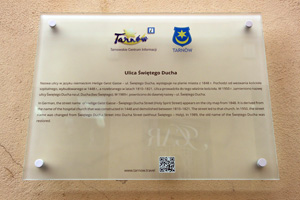
In German, the street name of Heilige Geist Gasse – Świętego Ducha Street (Holy Spirit Street) appears on the city map from 1848. It is derived from the name of the hospital church that was constructed in 1448 and demolished between 1810–1821. The street led to that church. In 1950, the street name was changed from Świętego Ducha Street into Ducha Street (without Świętego – Holy). In 1989, the old name of the Świętego Ducha was restored.
PLAC GENERAŁA JÓZEFA BEMA
The present name of the square has existed since 1950 and it was given on the 100th anniversary of death of general Józef Bem (1794–1850), who was an outstanding commander, Polish and Hungarian hero, born in Tarnów – as the local tradition says, in a house located next to the square. On the city map from 1848 the street name in German appears to be Heilige Geist Platz – Plac Świętego Ducha (the Holy Spirit Square). The name is derived from the hospital church that was constructed in 1448 and demolished between 1810–1821. The square common name is “Burek” and is derived from a cobbled road that led from the city to the castle.
ULICA GENERAŁA JÓZEFA BEMA
The present name of the square has existed since 1961. It was given by the Tarnów City National Board. Józef Bem (1794–1850), born in Tarnów, general, Polish and Hungarian hero, is the patron of the street. In the first half of the 19th century, the street was named Ogrodowa Street (Garden Street). It was named after the Holy Spirit hospital garden. Originally, it was reaching the present crossroad with Urszulańska Street. In 1929, western part of the street (from Urszulańska Street to Krakowska Street) was given name Marszałka Ferdynanda Focha Street (1851–1929), French Commander in Chief of the Allied Powers on the west front of the World War I, from 1923 also Marshal of Poland. In 1950, the name of the present section of the street was changed into Maurice’a Thoreza Street (1900–1964), French and international workers movement activist, leader of the French Communist Party. In 1956, this name was changed into Polskiego Października Street to honor the events and political changes of 1956. In 1961, the entire length of the street was given name Gen. Józefa Bema Street.
ULICA NAJŚWIĘTSZEJ MARII PANNY
In the present form, the name has existed since the end of the 19th century and is derived from a wooden church of the Virgin Mary Assumption. Already in 1621, in the documents the church is called as “church on a cobbled road, in other words – Burek”. The original name “Burek” concerned only this street that led to the castle located on the St. Martin Mountain. On the city map from 1848 the street was called in German Fleischer Gasse – Rzeźnicka Street (Slaughterhouse Street), possibly from the slaughterhouses that existed here. In 1878, the street name was changed into Cmentarna Street (Cemetery Street), i.e. leading to the cemetery in Zabłocie. In 1919, the street was given name Ignacego Jana Paderewskiego Street (1860–1941), an outstanding musician and politician, who on the very 16 day of January of this year became Prime Minister in the Polish Government. However, this name of the street was ignored also on the city maps issued by the Tarnów City Hall at that time. In 1938, it was finally decided that the name will not be changed and the old name – Najświętszej Marii Panny Street – returned.
ULICA PREZYDENTA GABRIELA NARUTOWICZA
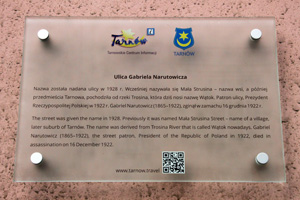
The street was given the name in 1928. Previously it was named Mała Strusina Street – name of a village, later suburb of Tarnów. The name was derived from Trosina River that is called Wątok nowadays. Gabriel Narutowicz (1865–1922), the street patron, President of the Republic of Poland in 1922, died in assassination on 16 December 1922.
ULICA LWOWSKA
On the city map from 1848 the street name in German appears to be Lemberger Gasse – ul. Lwowska (Lwowska Street). It was a section of “the Caesarian trackway” that led east to Lviv, capital of Galicia and was set out between years 1784–1785. Episodically and completely ignored by the Tarnów city citizens, the name of the street was changed by the resolution of the City National Board of 20 December 1949 into Generalissimusa Józefa Stalina (Generalissimo Joseph Stalin) (actually Josif W. Dżugaszwili) (1879–1953). After Stalin’s death, the old name of ul. Lwowska (Lwowska Street) was unofficially returned.
ULICA ADAMA MICKIEWICZA
In 1900, the newly constructed street was given name ul. Adama Mickiewicza (1798–1855) (Adam Mickiewicz Street), an outstanding romantic poet, recognized as the Polish national predictor. In 1951, the extension of this street was also named ul. A. Mickiewicza (Adam Mickiewicz Street). Since June 1934, the extension was named ul. Bronisława Pierackiego (Bronisław Pieracki Street) (previously Koszarowa Street). In the years 1931–1934 Bronisław Pieracki (1895–1934) was a minister of interior affairs in the government of the Republic of Poland. He was shot dead on 15 June 1934 in Warsaw by a Ukrainian nationalist.
ULICA ELIASZA GOLDHAMMERA
In 1913, the Tarnów City Board made a resolution that the old ul. Zdrojowa (Zdrojowa Street) was renamed to Eliasza Goldhammera, after Eliasz Goldhammer (1851–1912), a lawyer, a person active in self-governing bodies, Deputy Mayor of Tarnów in the years 1906–1911. The old name of ul. Zdrojowa (Zdrojowa Street) was used from the beginning of the 19th century and was derived from the aqueduct (spring) that brought in water to the city and ran along this street.
ULICA KAZIMIERZA BRODZIŃSKIEGO
At the beginning of the 20th century, the name of this street is ul. Ustronna (Ustronna Street). In 1906, it already appears as ul. Kazimierza Brodzińskiego (Kaziemierz Brodziński Street) (1791–1835), a poet and literary critic, student of the Tarnów secondary school (Gymnasium) in the years 1805–1809. The street took its name from the Kazimierz Brodziński School built here in 1896 (since 1948, seat of Adam Mickiewicz 3rd High School).
ULICA LEGIONÓW
First name of this street and actually of a dirt road going in the middle of the grange fields was “Kantoria”, because this grange was a property of Reverend Józef Króliński (1735–1798) in the years 1782–1783, a canon-cantor of the Collegiate in Tarnów. In 1805, a part of the soil was bought from the Religious Found by Prince Hieronim Sanguszko (1743–1812). Around 1879, in the corner building of the Wałowa and present Legionów streets, there was the post office building. Due to this ul. Kantoria (Kantoria Street) was changed into ul. Pocztowa (Pocztowa Street) in the section reaching from ul. Wałowej (Wałowa Street) until present ul. Asnyka (Asnyka Street). The further section used the name ul. Kantoria (Kantoria Street). On 27 January 1930, the entire length of the street was given name ul. Legionów (Legionów Street) to honor Polish Legions from the World War I, because on the subsequent year there was planned the 10th Meeting of the Polish Legions Association in Tarnów.
ULICA MARSZAŁKA JÓZEFA PIŁSUDSKIEGO
On the city map from 1848 the street name in German appears to be Seminar Gasse – ul. Seminaryjna (Seminaryjna Street). This name was derived from the Seminar building, constructed here in the years 1836–1838 that gave education to Roman Catholic priests. In 1921, the street name was changed into ul. Marszałka Józefa Piłsudskiego (Marszałka Józefa Piłsudskiego Street) (1867–1935), a politician and statesman, from November of 1920 – Marshal of Poland. On 7 January 1946, the street name was changed into ul. Ignacego Daszyńskiego (Ignacego Daszyńskiego Street) (1866–1936), a leader of Polish socialists, politician, the Republic of Poland Sejm Marshal in the years 1928–1930. In 1950, the street name was changed into ul. Janka Krasickiego (Janka Krasickiego Street) (1919–1943), a leader of the Association of Youth Fight (a communists youth organization during the World War II). In 1989, there was a return to the name of ul. Marszałka Józefa Piłsudskiego (Marszałka Józefa Piłsudskiego Street).
ULICA MIKOŁAJA KOPERNIKA (NICOLAUS COPERNICUS)
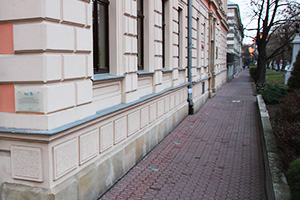
The street name appears in 1884 , when on the 3rd day of April the Tarnów City Board made a resolution to give it Mikołaj Kopernik (1473–1543) as a patron. He was a Polish outstanding astronomer, author of the heliocentric theory. In the years 1872–1874 a large building of a male branch school was constructed here. Its patron was Nicolaus Copernicus. Thus, the street name and construction of the Nicolaus Copernicus school had place almost at the same time.
ULICA KRAKOWSKA
From the 16th century until around 1800 the present ul. Katedralna (Katedralna Street) was called Krakowska Street. It led to the Krakowska Gate, through which it was possible to take a journey from the city to Kraków. After constructing “the Caesarian trackway” in the years 1784–1785 that ran from Silesia to Lviv, the present ul. Krakowska (Krakowska Street) was called the Silesian Road (Schlesiche Strasse) or Wojnicka Road (Chause von Voinic – exists in 1814). Together with development of the area on both sides of “the Caesarian trackway”, there was created a street that was called in the middle of the 19th century Krakowska. Officially, the name was established by the resolution of the Tarnów City Board made on 3 April 1884. Only on 9 November 1916 (5 days after proclamation made by the German and Austrian Emperors on 5 November 1916, on establishing an independent Polish country) Tadeusz Tertil (1864–1925), the mayor, called a meeting of the City Board in the City Hall and on his motion “the Board made an unanimous resolution to name the Krakowska Street in Tarnów as ul. Niepodłegłości (Niepodległości Street)”. Citizens of the city quickly forgot about this patriotic and brave act, as for that time, and they still called it and have done it until present day ul. Krakowska (Krakowska Street), although the City Board resolution made on 9 November 1916 was not revoked by anyone.